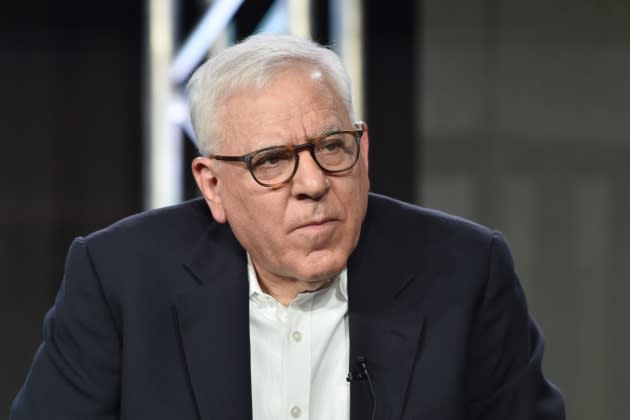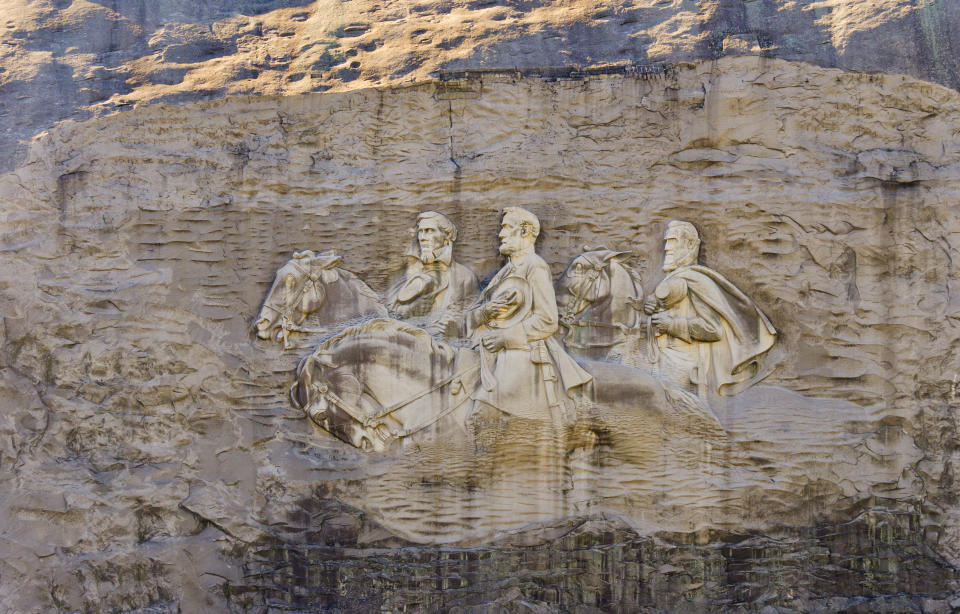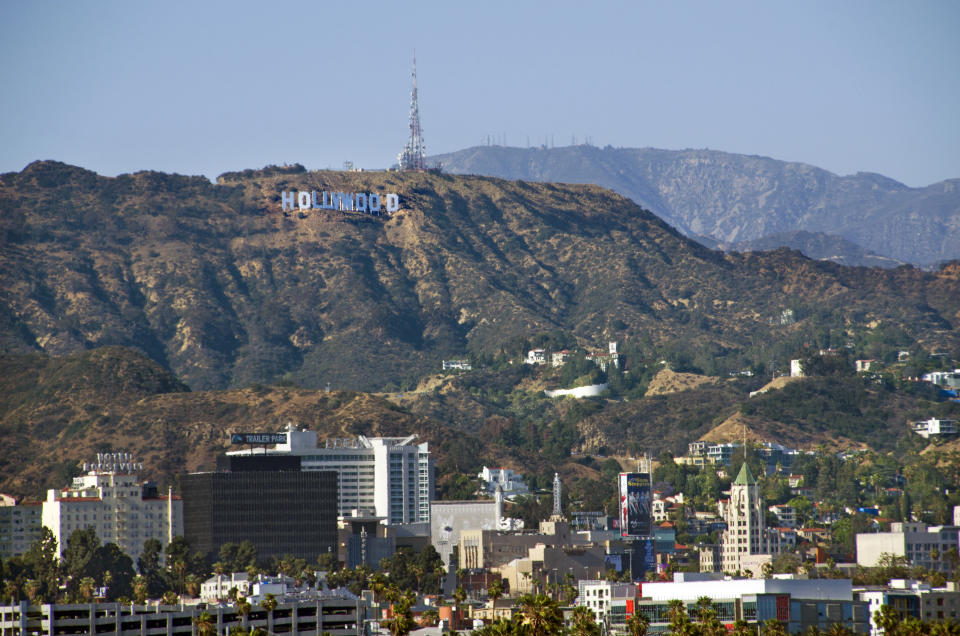David Rubenstein’s “Iconic America” Delves Into The Origins Of Monuments — And The Divides Over Their Meaning
- Oops!Something went wrong.Please try again later.
- Oops!Something went wrong.Please try again later.
- Oops!Something went wrong.Please try again later.

Walk around or near the National Mall in Washington, D.C. and chances are you will see the name David Rubenstein.
The co-founder of The Carlyle Group has funded restorations and expansions of the Lincoln Memorial, The Jefferson Memorial and the Washington Monument, along with the Kennedy Center, the National Museum of African American History and Culture and the Library of Congress. “All told, Rubenstein has shaped the cultural landscape of the nation’s capital perhaps more than any other private citizen in the past century,” NPR reported in 2020.
More from Deadline
Liz Cheney Zeroes In On Problem Of American Politics: "We're Electing Idiots"
PBS' 'A Capitol Fourth' Announces Lineup, Alfonso Ribeiro To Host
Rubenstein’s PBS series Iconic America, an eight-part series that has been running since the spring, expands on his philanthropic passions by delving into the origins and history of the meaning of monuments and symbols of the United States, from Fenway Park to the Statue of Liberty to the Hollywood sign.
The latest episode, debuting Tuesday, is perhaps the most controversial: Stone Mountain in Georgia, where the giant images of Confederate figures Jefferson Davis, Robert E. Lee and Stonewall Jackson are carved into hillside, while the area itself is linked to the rebirth of the Ku Klux Klan in 1915. “Should Confederate leaders remain on places like Stone Mountain, or should they be erased?” Rubenstein says in a preview.
Deadline spoke to Rubenstein about his hopes for the series, why America’s icons have such complicated histories, and how he views the removal of certain symbols of the past. Rubenstein also talks about the future of monuments and what makes them iconic places. On Tuesday, President Joe Biden is designating the latest national monument to honor Emmett Till and his mother.
DEADLINE: First off, the Stone Mountain episode. You said that this may have been the “most exhilarating” and even an “eye opener.” Why is that?
RUBENSTEIN: It’s the one I knew the least about in terms of the subject matter, even though I had lived in Atlanta. I worked for the Carter campaign in 1976. So I didn’t really know much about Stone Mountain. I never had visited before this. And then I was just amazed to learn that the vice president of the United States, Spiro Agnew, came to dedicate it in 1972. You think back on it today — dedicating a monument to a Confederate war heroes — the vice president of the United States. It does seem a little strange, doesn’t it?
I interviewed a number of people who know much more about it than I did, and I was surprised the chairman of Stone Mountain Memorial Association is an African American preacher and he seems to have no problems with doing that.
DEADLINE: Especially when you look back at the history and how it was connected to the KKK.

RUBENSTEIN: Most of the other episodes I knew something about the subject matter and obviously learned more doing it, but this was a clean slate for me.
The racial consciousness of the country was dramatically increased when the George Floyd death occurred. And although it was the death of one person, not many people, and he had not been exactly a hero like Martin Luther King, it really accelerated the racial concerns in this country, and in ways I wouldn’t have expected. So if we put this on the air 10 years ago, or 20 years ago, people would say, ‘Well, what’s the big deal?’ I think now people increasingly realize that the Confederacy was not just a harmless kind of thing that was trying to protect state rights. It was really a slavery related phenomenon.
DEADLINE: What gave you the idea for this series?
RUBENSTEIN: Over the years I’ve been involved in buying a lot of historic documents and putting them on display for Americans to see, and fixing a lot of historic buildings. And so I was looking for a way to communicate my interest in educating people about American history, and this was a way that was suggested to me, because Americans don’t know that much about our history, relatively speaking. And so I thought this was a good way to convey a history lesson to people, and doing in a friendly way and not in a way that’s going to be too controversial.
DEADLINE: Are you surprised by how little Americans know about history?
RUBENSTEIN: A survey was done of about two and a half million Americans recently about the citizenship test that naturalized citizens have passed. In 49 of 50 states, a majority of Americans who are born in this country couldn’t pass the basic citizenship test. … Two-thirds of Americans cannot tell you the three branches of government. Twenty-five percent of Americans think that Eisenhower was a general during the Civil War. It’s just stuff you just kind of roll your eyes. But we don’t teach civics very much anymore. We don’t teach American history anymore of any consequence. I think probably in China, people know more about our history than people in the United States.
DEADLINE: Lately we’ve heard so much about the this debate over monuments and symbols. And I often hear the phrase “woke” and “anti-woke.” You have said that you yourself had been labeled as as “too woke” for for helping finance the renovations at Monticello [the home of Thomas Jefferson]. How much of a concern was there that this series would be dragged into these debates?
RUBENSTEIN: There was an article in the New York Post which basically repeated a criticism that the Heritage Foundation had made. The Heritage Foundation had said that when you do a tour of Monticello and Montpelier now, you hear a lot about slavery, and because I put up the money to help redo those places, they accused me of being Mr. Woke. The truth is I have nothing to do with the tours. I basically put up the money. I did say, though, ‘Make the thing realistic. And if there were slave quarters in a certain place, build them out.’ And so in Mulberry Row, which is the slave quarter part of Monticello, they did build out the slave quarters. But I think if you say it’s too woke to show that Jefferson was a slave owner, I think that’s carrying things too far. In this world, if you try to do anything, you’re always going to be criticized. And the best way to avoid criticism is to do nothing. And if you do nothing, though, what’s the point of life? So I always try to say, ‘What can I do that could be helpful to country?’ And I’ll do what I think makes the most sense, and if people are going to be upset, what can I do?
DEADLINE: This is a show that features everything from the Statue of Liberty to the Hollywood sign to the Gadsden flag. I what I think is fascinating is that the meaning of these monuments often is different than what they were intended to be.
RUBENSTEIN: That’s true. As you saw, the Statue of Liberty was intended to be a sign of Franco-American friendship and thanking Americans for getting rid of slavery. It had nothing to do with immigration or welcoming immigrants. Because of the Emma Lazarus poem [later added to the monument] and other things, it became the symbol of immigration. So it’s amazing how these symbols change.
I should add, by the way, on Stone Mountain. I know that some Confederate monuments have been taken down. It’s not that difficult to take down a Robert E. Lee memorial statue, but this is something much more complicated. I think it is probably better to keep it there as a way to have people know that there were people who lived it for a period of time and wanted this up there. I think you don’t have to destroy every monument or memorial. Sometimes it’s a good thing to remember what other people thought, as a warning sign to some extent. Obviously getting rid of the the engravings on Stone Mountain would cost an extraordinary amount of money, probably would be too much controversy and not worth the effort. And so I think in some cases, it may be better to keep some things, but make sure people are educated about the plusses and minuses of the place.

DEADLINE: What has been your thinking on the taking down of many of the Confederate monuments, especially after George Floyd’s death? And did your view change over time?
RUBENSTEIN: Well, yes. My view has basically been this: If a monument is put up solely because somebody was a slave owner, and you want to actually protect the concept of slavery as a good concept, that’s probably not a good thing. But take the Washington Monument. There have been some people saying the Washington Monument or Jefferson Memorial should be taken down. Why? Because those were slave owners. Those monuments were not put up because they were slave owners. They were put up for other reasons. So if you’re putting up a statue of Robert E. Lee principally because he’s a slave owner, who was protecting slavery, that’s not something I think necessarily has to stay. I think like 10 of the first 12 presidents were slave owners, and so if you didn’t have any monuments or memorials to any of the first 10 presidents, would that be a good idea? Would it be a good idea to take the Washington Monument down? Probably not. So I think it depends on why the monument was put up. Many of these monuments to Robert E. Lee and other people like him, who fought in the Confederacy, were put up really in the beginning of the 20th century, when The Lost Cause was being developed as a concept.
DEADLINE: The Stone Mountain episodes goes into great depth about the origins of the Civil War. Why was it important this episode to point out that slavery was the reason? You go back and look at actual documents.
RUBENSTEIN: The Lost Cause concept developed in the early 20th century. The concept was that the southerners were trying to protect their way of life, that they were interested in protecting states rights, and that really, slavery wasn’t so bad, like the slaves actually kind of liked it. They were treated well. And it’s not true. In the end, it was the need to protect slavery against the perceived Lincoln effort to get rid of slavery that caused the Civil War, in my view. And I think that’s more accurate history than to say that the South was fighting for states rights.
DEADLINE: Shifting a bit to the Hollywood sign episode. Had you been there before and what surprised you about its history?
RUBENSTEIN: I had not gone up to the top of the Hollywood sign before. I did not know that the Hollywood sign had been erected because it was a Hollywood Land development company that was trying to sell houses. And so I learned that, and I found that Hollywood sign is actually over Hollywood, but Hollywood movies are no longer made in Hollywood, if ever they were. They’re made in Burbank or other parts of the Los Angeles area. And Hollywood just became a symbol of the movie-making world. But if you actually go to downtown Hollywood, there’s no movie studios there.
DEADLINE: Do you think the lack of access to the sign has impacted the way it has been perceived?
RUBENSTEIN: Not really. You can get you can get up to the Hollywood sign if you want. It has some fences around it, but you can get pretty close to it. But I don’t think that’s a big problem. The issue is really, what is it about the movie making world that makes people’s people’s hearts flutter? Why is it when somebody sees a movie star as opposed to somebody that won the Nobel Peace Prize, why people seem to be losing all sense of proportion about the importance of the person. It’s amazing that if you put somebody’s picture up on a big screen, and they’re an actor, and they’re just playing a role, that all of a sudden people become enamored with these people and want to get their autographs or pictures and and idolize them. Whereas if I introduced the five people that won the Nobel Peace Prize, they probably wouldn’t care less.
DEADLINE: Do you think that political polarization will make it more difficult to create new monuments?
RUBENSTEIN: It’s certainly harder to build monuments and memorials today because you have people who don’t like the person who is being immortalized. They can protest it. It may be blocked. So I think it’s much harder to build monuments and memorials today than it was 50 years ago, 100 years ago for sure.
DEADLINE: You have helped with the revitalization and repair of so many of these monuments. Are there more on your agenda?
RUBENSTEIN: I have a few that I’m looking at that I don’t want to mention now because if I don’t, I don’t want people to be upset, people who worked there. But I have a couple that I hope to be able to do in the near future. There’s an infinite number of monuments and memorials. I wish there were more people doing it, but I’m doing it now because I enjoy it and I think it’s a good thing for the country.
DEADLINE: What do you think will happen to Stone Mountain?
RUBENSTEIN: First of all, it’s the state of Georgia owns it. And the state of Georgia legislature is not likely to want to make a change in it. My view. So I don’t think anything will happen anytime soon, or anytime ever. But I think right now, there’s just too much political opposition to getting rid of the memorials. And I think it’s probably not a good idea to get rid of. I think you should use it as a learning tool, kind of show people what people believed in, in the early part of the 20th century and through much of the 20th century.
DEADLINE: What makes a monument an iconic place for people?
RUBENSTEIN: It means something to them. For example, the Washington Monument, it’s a very simple building. It’s not all that complicated. It’s more or less an obelisk, but people flock to it because they kind of identify George Washington as a hero of the country and as our first president, the general that won the Revolutionary War and so forth. And so I think monuments or memorials will continue to be built to honor certain causes, or to honor certain people. Take the Vietnam War Memorial. That was very controversial. Many people didn’t want it to be built, certainly in the design. Then it turned out to be one of the most popular monuments in Washington. When the Eiffel Tower was built people thought it was the ugliest building ever built. Now it is sort of a symbol of Paris.
Rubenstein is executive producer of the series, which also is available online and for streaming. Other executive producers are Maro Chermayeff, Jeff Dupre, Joshua Bennett and Sam Pollard for Show of Force. John F. Wilson is executive producer for WETA. Bill Gardner is the executive in charge for PBS.
Best of Deadline
2023 Premiere Dates For New & Returning Series On Broadcast, Cable & Streaming
SAG-AFTRA Interim Agreements: List Of Movies And Series Granted Waivers
Hollywood & Media Deaths In 2023: Photo Gallery & Obituaries
Sign up for Deadline's Newsletter. For the latest news, follow us on Facebook, Twitter, and Instagram.

